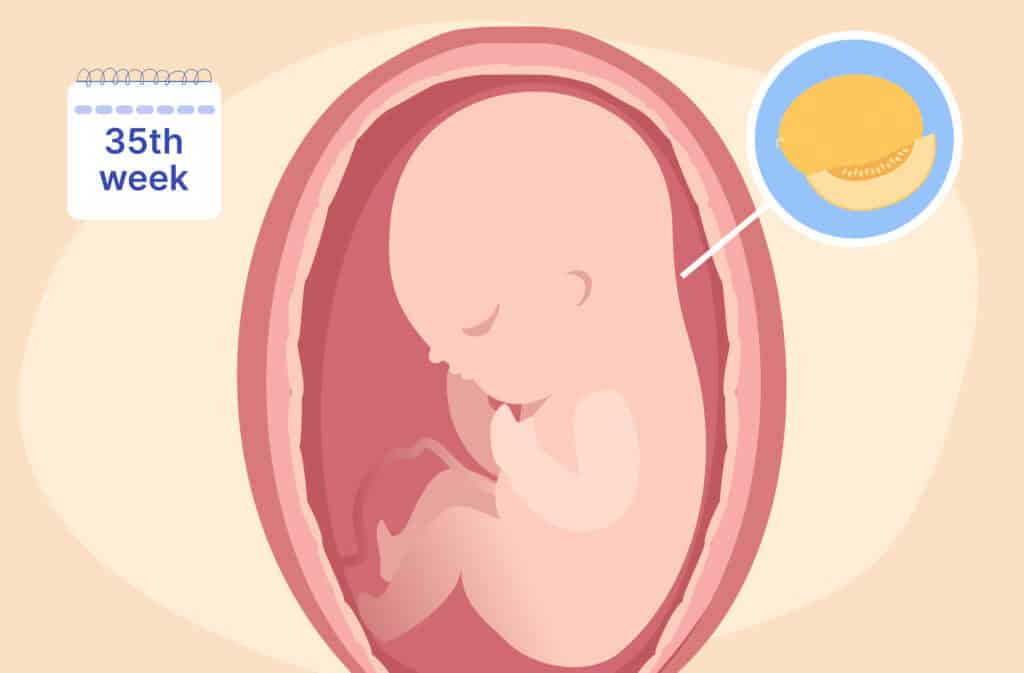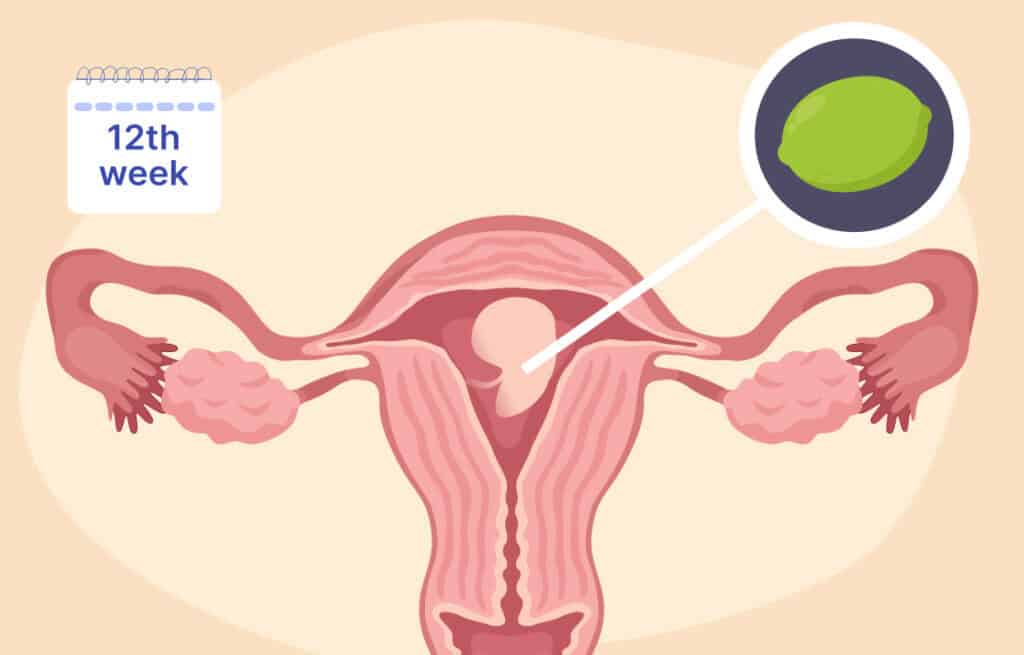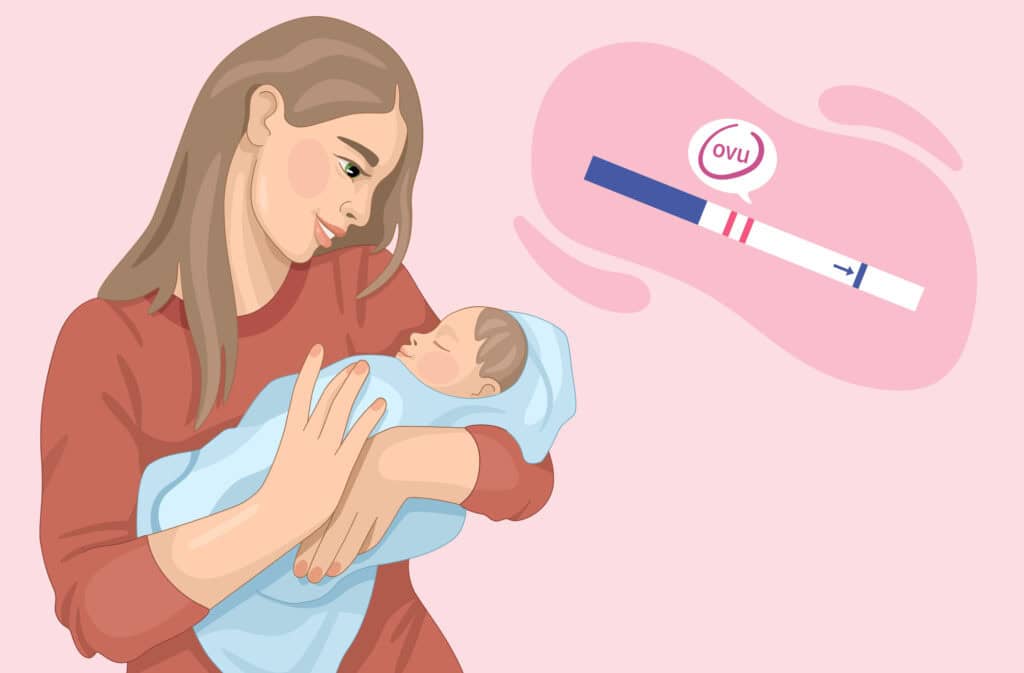Femia > Health Library > Pregnancy > Pregnancy week by week > Week 35 pregnancy: Symptoms, baby milestones, and delivery prep
Week 35 pregnancy: Symptoms, baby milestones, and delivery prep

- Updated Feb 14, 2025
- Published
CRAFTED BY HUMAN
Crafted by human At Femia, we provide accurate and up-to-date information at every stage of your journey, from trying to conceive, pregnancy and postnatal support. All content is created by a real person based on in-depth research and own professional experience. Femia ensures that you will receive expert advice, strict accuracy and a personalized approach from our authors/medical experts. Learn more about our editorial policy.
FACT CHECKED
Fact checked At Femia Health, we maintain the highest standards of editorial excellence in delivering content focused on helping you conceive, guiding you through pregnancy, and supporting you postpartum. Explore our content review principles to learn how we ensure the accuracy and quality of our health and lifestyle tips for every stage of your journey.
At 35 weeks pregnant, your baby is nearing full-term readiness, focusing on weight gain and lung development. At this stage, they weigh around 2.4 kilograms (5.3 pounds) and are approximately 18-19 inches long. For you, it’s time to prepare for delivery while managing symptoms like fatigue and nausea.
You’re now 35 weeks pregnant—just five weeks to go until your due date! Your baby is continuing to grow, gaining weight, and putting the finishing touches on vital organ development. As your body prepares for labor, it’s important to monitor symptoms and avoid triggers that could increase discomfort. Let’s explore what to expect at week 35 of pregnancy and how to manage the final stretch.
Track your symptoms with Femia and get tailored
health advice right on your phone
Pregnancy symptoms at 35 weeks
Heartburn
At 35 weeks, heartburn can become more frequent as your growing uterus pushes against your stomach, increasing pressure. This may cause acid reflux and discomfort. To relieve heartburn, avoid trigger foods, eat smaller meals, and try propping yourself up while resting.
Clumsiness
Your center of gravity shifts as your baby grows, making you feel clumsier than usual. This can result in dropping things or having trouble balancing. Make sure to move slowly and use support when needed.
Headaches
Headaches can be triggered by fatigue, hunger, dehydration, or stress. To alleviate them, try applying a compress, staying hydrated, and practicing relaxation techniques. However, if your headache is severe, contact your doctor as it could be a sign of preeclampsia.
Hemorrhoids
Hemorrhoids, caused by the growing uterus, increased progesterone, and constipation, are common at 35 weeks. To manage them, stay hydrated, eat a high-fiber diet, and avoid straining during bowel movements. If needed, use cold compresses or consult your doctor for medication.
Linea nigra
The dark vertical line down your belly, known as linea nigra, is a common pregnancy symptom. It occurs due to hormonal changes and will likely fade after delivery. Using sunscreen and hypoallergenic skincare products can help reduce further darkening.
Vision changes
Vision changes like blurry vision or dry eyes are normal due to hormonal shifts in pregnancy. However, if you experience severe vision changes or symptoms like double vision or flashing lights, contact your healthcare provider immediately as they could be signs of preeclampsia or other serious conditions.
Hot flashes
At 35 weeks pregnant, hormonal changes can lead to hot flashes, which are sudden feelings of heat and sweating, often followed by chills. These can be triggered by increased blood flow and fluctuations in estrogen levels. To manage hot flashes, wear loose, breathable clothing, stay hydrated, and avoid hot environments. If the hot flashes become severe or frequent, consult your doctor.
Braxton Hicks contractions vs true labor
| Aspect | Braxton Hicks Contractions | True Labor |
|---|---|---|
| Frequency | Irregular, not progressively closer together | Regular intervals, getting closer together |
| Intensity | Weak, often described as mild discomfort | Increases in strength over time |
| Duration | Short, usually lasting less than 30 seconds | Longer, lasting 30-70 seconds per contraction |
| Location of Pain | Felt mainly in the front of the abdomen | Starts in the back and radiates to the front |
| Effect of Movement | Stops or decreases with activity or a change in position | Continues regardless of movement or position changes |
| Cervical Changes | Does not cause dilation or thinning of the cervix | Causes the cervix to dilate and thin out (effacement) |
Symptoms not to ignore at 35 weeks
Severe stomach pain
If you experience intense pain on the top right side of your stomach, it could be a sign of preeclampsia, liver issues, or other serious complications. Preeclampsia is a pregnancy condition characterized by high blood pressure and can lead to organ damage or affect fetal health. This type of pain should never be ignored and warrants immediate consultation with your healthcare provider to rule out dangerous conditions.
Regular, painful contractions
Contractions that occur regularly and increase in intensity, especially if they are accompanied by other symptoms like lower back pain or pelvic pressure, could indicate preterm labor. While Braxton Hicks contractions are normal and usually painless, consistent and painful contractions could signal that labor is starting prematurely. If you’re experiencing these contractions, it’s essential to contact your doctor or midwife immediately to assess the situation and take the necessary steps to prevent premature birth.
Reduced baby movements
A significant reduction in your baby’s usual movements, such as a noticeable decrease in kicking or rolling, should be reported to your provider without delay. While some variation in fetal movement is normal, a sudden, sustained decrease could indicate potential issues like fetal distress, low amniotic fluid, or other complications. Early intervention is crucial to ensure your baby’s well-being, so don’t hesitate to seek medical advice if you notice any concerning changes.
Your body at 35 weeks pregnant
At 35 weeks pregnant, your growing baby is taking up more space, and you may notice that your belly is noticeably larger and heavier. As your baby continues to grow, their movements may become less pronounced, as there is less room in your uterus. However, you might still feel occasional strong kicks or rolls, though these movements are likely to feel more restricted due to the space limitations.
As your baby settles lower into your pelvis in preparation for birth, you may feel increased pressure in that area. This pelvic pressure is common at this stage, and it can make walking or sitting for long periods more uncomfortable. Along with these physical changes, you might also experience back pain and a shift in your center of gravity as your body adapts to support the added weight.
35 Weeks pregnant in months
You are approximately 8.75 months pregnant, with just a few weeks left until full term.
35-Week pregnant belly
Your belly is likely at its heaviest, and you may experience itching or tightness as your skin stretches. Using a good moisturizer can help alleviate these symptoms.
Baby development at 35 weeks
At 35 weeks pregnant, your baby is continuing to gain weight, adding essential fat under their skin to help regulate body temperature after birth. Their lungs are nearly fully mature, and they are honing critical skills like sucking and swallowing, which will be necessary for feeding after birth. As their growth accelerates, they are focusing on building strength and preparing for life outside the womb.
Baby size at 35 weeks
- Weight: Around 2.4 kilograms (5.3 pounds)
- Length: Approximately 18-19 inches, about the size of a honeydew melon.
Baby movements
As your baby has less space to move, you may feel stretches, kicks, and rolls, although the movements might not be as pronounced as before. With the baby’s head-down position in preparation for birth, you’ll likely experience more pressure in your pelvis, but you should still feel some activity, even if it’s less frequent or more restricted.
35-Week ultrasound
A 35-week ultrasound may be done to check your baby’s growth, position, and amniotic fluid levels. This scan can also confirm if your baby is head-down in preparation for delivery.
35-Week preemie: What to expect
A baby born at 35 weeks is considered late preterm and has an excellent 99% survival rate with proper care.
Development and care:
- Lungs: Nearly mature, though breathing support may occasionally be needed.
- Feeding: Some preemies may require assistance until sucking and swallowing reflexes are fully developed.
- NICU support: Monitoring may include temperature regulation and jaundice treatment.
Most babies born at 35 weeks thrive with minimal intervention and typically catch up to their full-term peers within the first year.
Track your symptoms with Femia and get tailored
health advice right on your phone
Tests to expect at 35 weeks pregnant
Your healthcare provider will continue routine checks and tests to monitor your health and your baby’s development:
- Blood pressure check: Detects signs of preeclampsia or hypertension.
- Fetal heartbeat and movements: Your provider will monitor your baby’s activity and heart rate.
- Urine test: Screens for protein and glucose levels to rule out gestational diabetes or preeclampsia.
- Group B strep (GBS) test: This test is typically performed between 35-37 weeks to check for GBS bacteria. If positive, antibiotics will be given during labor to protect your baby.
- Fundal height measurement: Ensures your uterus is growing appropriately.
Things to avoid at 35 weeks pregnant
- Heavy lifting: Avoid activities that put additional strain on your back.
- Stress: Practice relaxation techniques to reduce stress levels.
- Standing for long periods: Elevate your feet when possible to reduce swelling.
- Unpasteurized foods: Continue avoiding soft cheeses, raw seafood, and deli meats to reduce the risk of infection.
👉Find out more:
36 Weeks pregnant: Baby weight, discomfort relief, and delivery prep
37 Weeks pregnant: Labor signs, baby development, and discomfort relief
Health tips and self-care at 35 weeks pregnant
Stay hydrated
Drinking plenty of water is crucial during pregnancy, especially at 35 weeks, to reduce swelling, prevent dehydration, and support circulation. Aim for 8-10 glasses of water a day, and make sure to drink more if you’re feeling thirsty or are in a warmer climate. Staying hydrated helps maintain amniotic fluid levels and aids your body in adjusting to the increased blood volume.
Rest and sleep
Your body is working hard as you approach your due date, so make sure to take frequent breaks and rest whenever possible. It’s common to experience difficulty sleeping at this stage due to physical discomfort, such as pressure on your pelvis, and the growing size of your belly. To get better sleep, try sleeping on your left side, which can improve circulation. Use pillows for support to relieve pressure from your back, and elevate your legs to reduce swelling.
Prepare for labor
Now is a good time to review your birth plan, familiarize yourself with labor signs, and start practicing relaxation techniques such as deep breathing and visualization. Doing pelvic floor exercises, also known as Kegels, can help strengthen the muscles used during labor and improve recovery post-birth. Continue communicating with your partner and healthcare provider about your preferences and any concerns you may have.
Monitor baby’s movements
It’s important to track your baby’s movements at this stage. While their movements may feel less intense due to limited space, you should still feel regular activity. If you notice any significant decrease in your baby’s usual movement patterns, contact your healthcare provider immediately for reassurance or to address any potential complications.
Address any pain or discomfort
Back pain, pelvic pressure, and other discomforts are common at 35 weeks pregnant. Consider using a pregnancy pillow for additional back support during sleep and while sitting. Gentle stretching, warm baths, and practicing relaxation techniques can also provide relief. If you experience severe or persistent pain, especially in the lower abdomen or pelvic area, speak to your doctor to rule out potential complications.
Avoid heavy lifting and overexertion
As your body carries more weight, it’s important to avoid lifting heavy objects, bending too much, or overexerting yourself. These activities can strain your muscles, ligaments, and joints, leading to increased discomfort or injury. When bending, squat down instead of bending at the waist to avoid pressure on your back.
Wear comfortable clothing
Opt for loose, comfortable clothes to prevent added stress on your body. Maternity clothing that provides gentle support can help with comfort, especially for your growing belly. Avoid tight shoes or clothing that restricts circulation, and consider wearing compression stockings if you experience swollen feet or ankles.
Questions from the Femia community
Is breastfeeding better than formula?
Breastfeeding provides essential nutrients and antibodies that boost your baby’s immune system, reduce the risk of infections, and promote bonding. However, formula feeding is a safe alternative that ensures your baby gets proper nutrition if breastfeeding isn’t possible. The choice depends on your personal circumstances and comfort level. Discuss your options with your healthcare provider to make the best decision for you and your baby.
How to overcome concerns about sex before giving birth?
It’s normal to feel anxious about intimacy during late pregnancy. Communication with your partner is key—share your feelings and set boundaries that make you feel comfortable. Physically, sex is safe in most cases unless your provider advises against it. Opt for positions that reduce pressure on your belly, and always stop if you feel discomfort or pain.
Is my baby fully formed at 35 weeks?
At 35 weeks, your baby is nearly fully formed. Their organs, including the lungs and brain, are still maturing, but most systems are functioning. The baby is gaining weight and developing fat to regulate body temperature after birth.
How do I know when I am close to labor at 35 weeks?
Signs of approaching labor include regular contractions, lower back pain, pelvic pressure, and the loss of your mucus plug. If you notice any of these signs or feel concerned, contact your healthcare provider for guidance.
The bottom line
At 35 weeks pregnant, your baby is nearly full term and preparing for birth. Focus on monitoring symptoms, avoiding triggers that cause discomfort, and finalizing your labor plans. Stay informed about preterm labor signs and self-care tips to navigate the last stretch of pregnancy with confidence.
References
- “35 Weeks Pregnant: Symptoms, Baby Development & Tips.” BabyCenter, www.babycenter.com/pregnancy/week-by-week/35-weeks-pregnant.
- “Week 35 of Pregnancy: Symptoms, Baby Development & More.” What to Expect, www.whattoexpect.com/pregnancy/week-by-week/week-35.aspx.
- “35 Weeks Pregnant: Baby Development, Symptoms & Tips.” NHS, www.nhs.uk/pregnancy/week-by-week/1-to-12/35-weeks/.
- “Pregnancy Week 35: What to Expect.” American Pregnancy Association, www.americanpregnancy.org/healthy-pregnancy/week-by-week/35-weeks-pregnant/.

What are the risks and benefits of period sex? Click to read the complete guide with all the information you need to know and tips for a comfortable experience!

At 12 weeks pregnant, your baby’s organs are forming, and a bump may appear. Explore fetal development, symptoms, and what to expect in week 12.

Discover how to identify signs of ovulation after giving birth, when fertility may return, and tips for tracking ovulation while breastfeeding. Learn more now.

